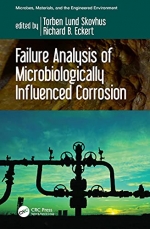Tab Article
Failure Analysis of Microbiologically Influenced Corrosion serves as a complete guide to corrosion failure analysis with an emphasis on the diagnosis of microbiologically influenced corrosion (MIC). By applying the principles of chemistry, microbiology, and metallurgy, readers will be able to reliably determine the mechanistic cause of corrosion damage and failures and select the appropriate methods for mitigating future corrosion incidents.
FEATURES
- Provides background information on the forensic process, types of data or evidence needed to perform the analysis, industrial case studies, details on the MIC failure analysis process, and protocols for field and lab use
- Presents up-to-date advances in molecular technologies and their application to corrosion failure investigations
- Offers specific guidelines for conducting MIC failure analyses and case studies to illustrate their application
- Examines state-of-the-art information on MIC analytical tools and methods
With authors with expertise in microbiology, corrosion, materials, and failure investigation, this book provides tools for engineers, scientists, and technologists to successfully combat MIC issues.


